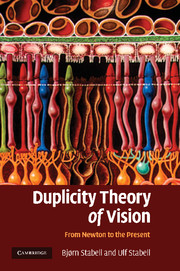Book contents
- Frontmatter
- Contents
- Acknowledgements
- 1 Introduction
- Part I The development of the basic ideas of the duplicity theory from Newton to G. E. Müller
- Part II The development of the duplicity theory from 1930–1966
- Part III Chromatic rod vision: a historical account
- Part IV Theories of sensitivity regulation of the rod and cone systems: a historical account
- 15 Introduction
- 16 Early photochemical explanations
- 17 Contribution of S. Hecht
- 18 Contribution of G. Wald: photochemical sensitivity regulation mechanisms of rods and cones
- 19 Relationship between amount of rhodopsin and sensitivity during dark adaptation
- 20 Post-receptor sensitivity regulation mechanisms
- 21 Rushton's AGC model
- 22 Contribution of H.B. Barlow
- 23 Rushton and Barlow compared
- 24 The Dowling-Rushton equation refuted
- 25 Several mechanisms involved in sensitivity regulation
- 26 Sensitivity regulation due to rod-cone interaction
- 27 Modern conceptions of sensitivity regulation
- Part V Factors that triggered the paradigm shifts in the development of the duplicity theory
- References
- Index
18 - Contribution of G. Wald: photochemical sensitivity regulation mechanisms of rods and cones
Published online by Cambridge University Press: 22 January 2010
- Frontmatter
- Contents
- Acknowledgements
- 1 Introduction
- Part I The development of the basic ideas of the duplicity theory from Newton to G. E. Müller
- Part II The development of the duplicity theory from 1930–1966
- Part III Chromatic rod vision: a historical account
- Part IV Theories of sensitivity regulation of the rod and cone systems: a historical account
- 15 Introduction
- 16 Early photochemical explanations
- 17 Contribution of S. Hecht
- 18 Contribution of G. Wald: photochemical sensitivity regulation mechanisms of rods and cones
- 19 Relationship between amount of rhodopsin and sensitivity during dark adaptation
- 20 Post-receptor sensitivity regulation mechanisms
- 21 Rushton's AGC model
- 22 Contribution of H.B. Barlow
- 23 Rushton and Barlow compared
- 24 The Dowling-Rushton equation refuted
- 25 Several mechanisms involved in sensitivity regulation
- 26 Sensitivity regulation due to rod-cone interaction
- 27 Modern conceptions of sensitivity regulation
- Part V Factors that triggered the paradigm shifts in the development of the duplicity theory
- References
- Index
Summary
This hypothesis of Kühne and Hecht must be considered an important insight with regard to biochemical processes underlying dark adaptation. Yet, it only represented a first step towards an understanding of the highly complex processes involved in the photochemical sensitivity regulation mechanisms of rods and cones. Obviously, a deeper understanding would require more information on both the molecular structure of the rod and cone photopigments and the bleaching and regeneration processes generated by light.
MOLECULAR BASIS OF BLEACHING AND REGENERATION OF PHOTOPIGMENTS IN RODS AND CONES
Inspired by Hecht, Wald, in the early 1930s, set out to throw light on these largely unexplored research topics (see Wald, 1949a, 1958, 1968). His profound discoveries and insights earned him the Nobel Prize which he shared with Granit and Hartline in 1967.
Firstly, he discovered vitamin A in the retina (Wald, 1933, 1934/1935). Shortly thereafter, he concluded that the photopigment rhodopsin was a conjugated carotenoid-protein engaged in a bleaching-regeneration cycle when acted upon by light (Wald, 1934, 1935/1936). Thus, in line with the hypothesis of Kühne and Hecht that light decomposes rhodopsin into its two precursors, Wald presumed that the caroteoids, all-trans retinal (vitamin A aldehyde) and vitamin A represented both photoproducts and precursors of rhodopsin.
- Type
- Chapter
- Information
- Duplicity Theory of VisionFrom Newton to the Present, pp. 140 - 146Publisher: Cambridge University PressPrint publication year: 2009



